“Oh my GOD! Look at that one,” I said, pointing to a dull grey stone lying at the bottom of a crumbling wall of limestone. Heather Cowper, who writes the ever popular travel blog Heather on her Travels, and I scrambled over the boulders that littered the beach to get a closer look.
“It’s the reverse impression of an Ammonite fossil,” I explained. It was huge and definitely not a specimen I was going to collect. Notwithstanding its size and weight, which would have cost me a fortune to ship, I no longer have a home in which to display it. This one was meant for a local who is as addicted to rockhounding as I am.
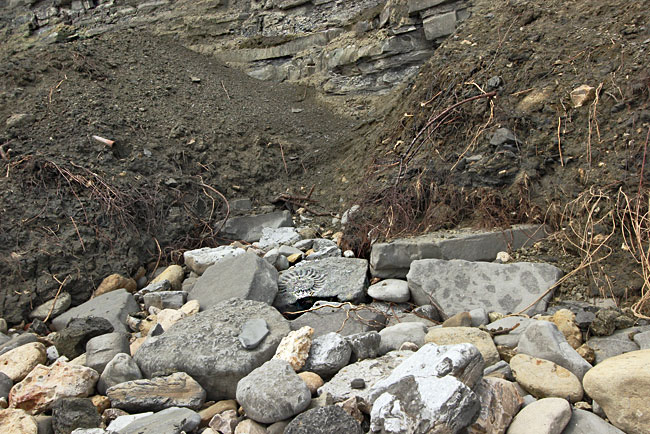
Heather and I were headed for the Ammonite Pavement, a geologic formation I had learned about the previous day from the friendly owner of a rock store in the town of Lyme Regis, in Dorset, England. Best seen at low tide, this flat shelf of dull grey limestone, located on the western reaches of Monmouth Beach, is famous for the thousands of fossils it contains. Most prevalent are Ammonites, an ancient sea creature related to our present-day squid. During some cataclysmic event, the details of which are unknown, there was a mass die-off of Ammonites. They sank to the sea floor and were embedded in the mud, where their tentacles and soft body parts decomposed, leaving only their coiled, Nautilus-like shell.
Over eons, their shells were covered by mud and other sediments until they lay deep beneath the ocean floor. Gradually the heat and pressure generated by overlying deposits hardened the shells into calcite fossils. Then, about 100 million years ago, during a time of active plate tectonics, the rocks that form today’s southwest coast of England were uplifted and tilted toward the east. Once exposed to the elements, the more recent soft layers eroded, revealing the shelf of Ammonites (click here for an excellent graphic and explanation of how the Ammonites were exposed by the earth’s geologic forces).
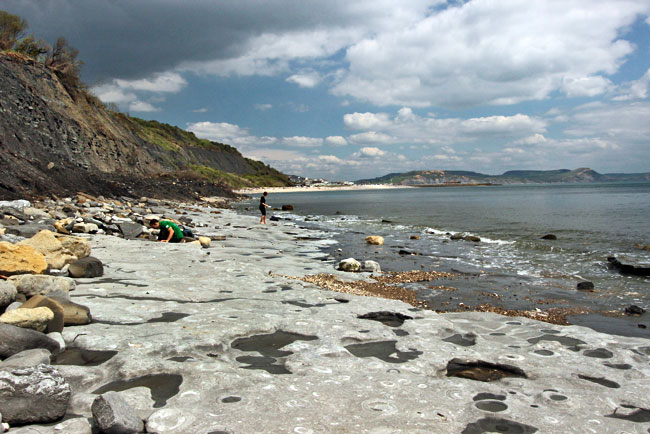
With the tide not yet fully out our trek was a bit challenging, especially when rounding a small point where the cliff had recently slumped and deposited clay. Timing the waves imperfectly, I slipped on the slick wet clay and only just avoided falling. But beyond that it was easy going. Ahead stretched the flat shelf of weathered limestone, covered in a sea of enormous fossils. I sat on the pavement and closely examined these specimens, marveling that they had preserved the minutest details of a 200-million year old sea creature.
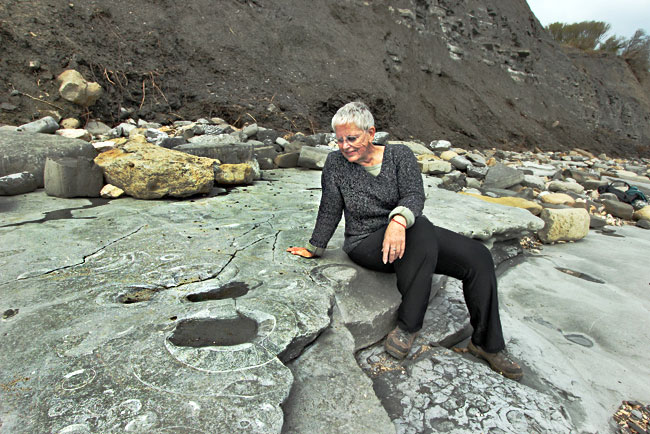
Though it is not allowed to extract these larger embedded Ammonites, there was no lack of loose smaller fossils and we stuffed our pockets with a few of the better ones before heading for our second fossil hunting adventure of the day. Just a few miles to the east, we parked at the beach in Charmouth and checked in at the Charmouth Heritage Coast Centre for a two-hour guided fossil hunting walk. After a thorough briefing by a warden who had extensive knowledge of the geologic formations and the types of fossils they held, we followed her down the beach and started hunting.
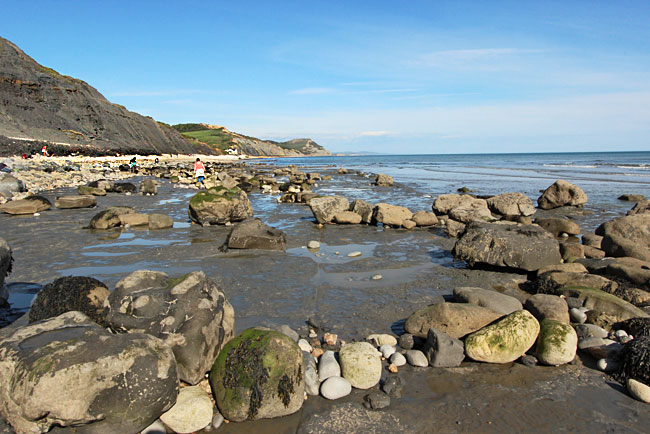
With my bad knee and hip I lagged behind. Worried, Heather doubled back to check on me. Satisfied that I was doing OK, she grinned and held out her hand, displaying a dozen small fossils known as Belemnites that resemble the tip of a pencil, or, when the tip is broken, a tiny roll of toilet paper.
“They’re everywhere,” she said. “They seem to be the easiest fossil to find.”
I finally made it to the prime hunting grounds and started scanning the shingle on the beach. I had no success at first but then finally spotted my first Belemnite. Like magic, once my eyes knew what to look for, they were everywhere. At one point I spied a hunk of iron pyrite, commonly called fool’s gold because early prospectors mistook it for true gold. It was circular and covered in botryoidal crystal formations that look like small bumps or blisters. I was about to toss it away when I thought better and asked the warden about it.
“That IS an Ammonite!” She explained that in this case iron pyrite, rather than the normal calcite, had gradually replaced the shell. “It’s not a pretty one, because it’s all lumpy and much of the actual shape is buried beneath the bumps, but if you look closely you can still see the spiral.” And indeed, once I knew what it was, I could see the faint outline of the Ammonite shell.
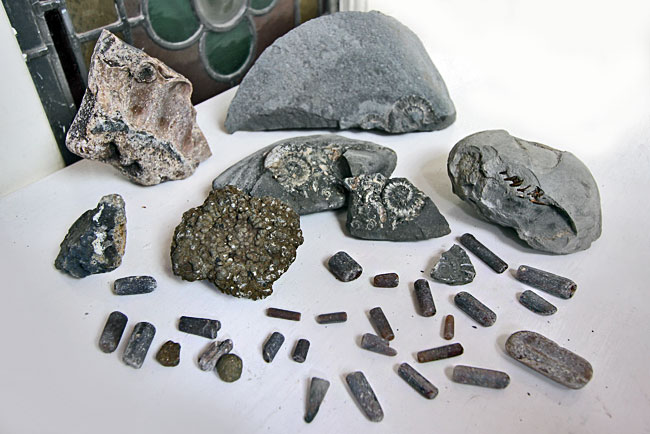
We spent the better part of that afternoon bent over from the waist, scanning rocks and detritus on the beach. In the end, I carried away a couple dozen fossils, an absolute boon to a collector like me. I shipped them back to my Dad, who emailed back upon receipt, “I’ll put them in the closet with the other boxes of rocks.” It is an endless source of amusement to my family that I have no home and very few remaining possessions, but I insist upon holding onto my collection of rocks. What can I say? There’s a certain fascination about walking back through time and holding in my hand the fossilized remains of a creature that had lived eons ago. There’s ample reason this area of England is called the Jurassic Coast.
Notes on fossil collecting:
- To reach the Ammonite Pavement, from the car park at the Lyme Regis Harbour, walk west on Monmouth Beach for about half a mile. Please respect the fossils in the limestone pavement and do nothing to harm them. Leave them there for others to see and enjoy.
- The Charmouth Heritage Coast Centre’s Fossil Collecting Code requires collectors to prospect only on the beach and not to dig in the cliffs without permission, as landslides are prevalent. Collectors are also advised to wear goggles and use geological hammers, to watch out for mudflows and be aware of the tides. They are also expected to record specimens of key scientific importance at the Centre. Because fossils will be destroyed by the sea if not collected, the Centre recognizes that it is very important to work with the local collectors who are able to go out at a moments notice after big winter storms and landslides. Their knowledge and experience of the local coast and its fossils makes them key to recovering scientifically important specimens. If collectors abide by the code, ownership of the fossils they find on National Trust and Charmouth Parish Council land is transferred to them.
- Those of you who are not inveterate rockhounds like me, never fear. Lyme Regis is awash with interesting things to do. So you can drop your rock-hunting friends and family members off at the fossil beds and head for the museums, beaches, harbour, boutiques, and galleries in this adorable Dorset town.

Congratulation for excellent pics and fossils, specialy this kind of giant ammonites. Just a one good photo from close of that gig.amon.on 1st.pics can be a very valuable. So, I have no doubt that you had took a very close watching and photos of them, without damaging this unique fossil, besides it is only shell cast. Greetings from southern Bosnia and Herzegovina, you can see many fossils from my country on my portal: http://www.hercegovina-geoarheo.blogspot.com
Hi Goran: Thanks for your comment. I will undoubtedly visit Bosnia and Herzegovina some day, so I’ll read up on the fossils there.
Wow, those fossils are amazing!
Thanks Mary – I had a blast finding them.
Your blog is one of a kind and your adventures as well. Most travelers venture to places just to take pictures, relax and unwind.. I love your venture for fossils! Legend!
Thanks Punta Mita – I always try to search out unusual experiences in the destinations I visit.
Isn’t the country’s historical institution or archaeologists interested in keeping or studying them at least?
Hi Monnette: They do ask that if anything unusual is found it be reported to the proper agencies, who will document it before giving it back to the person who found it. Mud from the cliff slips and falls every day, so they realize that working with amateur fossil collectors is a must, because without their prospecting most of the finds would be washed out to sea and lost forever.
Rock on, Barbara. What a trip!
Those fossils are so cool. Would love to go fossil hunting!! Sounds like a really fun experience.
It’s a fascinating day out Debbie.If rocks interest you at all, it can’t be beat.
Wow, what a great sounding place to fossick. The ammonites look so real even today – incredible that they are so well preserved after so long. Most of these places are locked up so tightly that no one gets near them so great to see such a positive initiative. It is how David Attenborough started being interested in fossils near where he grew up…
Wow, what a great sounding place to fossick. The ammonites look so real even today – incredible that they are so well preserved after so long. Most of these places are locked up so tightly that no one gets near them so great to see such a positive iniative. It is how David Attenboroguh started being interested in fossils near where he grew up…
That place looks amazing! I love finding fossils, but I’ve never seen such large and perfect ones in the ‘wild’ like that – they look like museum pieces.
Amazing how rich the place is with fossils
Two years ago, my then 9-year-old daughter was mad about fossils, so going from Cornwall to London, we stopped in Lyme Regis to have a look at the fossil museum and to stumble around a bit. Didn’t know one could take guided fossil hunting walks, she would have liked that. Sounds like you had an interesting experience.
It was really interesting Sophie. But dangerous for me, because I just can’t stop picking up rocks and shipping them back to the US!
Those HUGE fossils are amazing! I love fossils in general, but WOW!!
My reaction EXACTLY santafetraveler 🙂
That is really amazing and I’m with you, I would be shipping them back home and holding onto them too! We have fossil hunting areas near our home in Florida and our entire family loves to hunt for them whenever we have the time. As you said, there’s just something about holding the fossilized remains of something that lived on this earth eons ago.
Hi Barbara: Never really thought about fossil hunting in Florida and I lived there three years, but I guess there’s plenty of limestone, so plenty of fossils. Nice to know there are others out there who feel the same way I do about those ancient critters preserved in rock!
It was a fun day out – I didn’t realise until then that these fossils were things that you could easily find yourself when you know where to look and what to look for – they’re not just things to find in a museum.